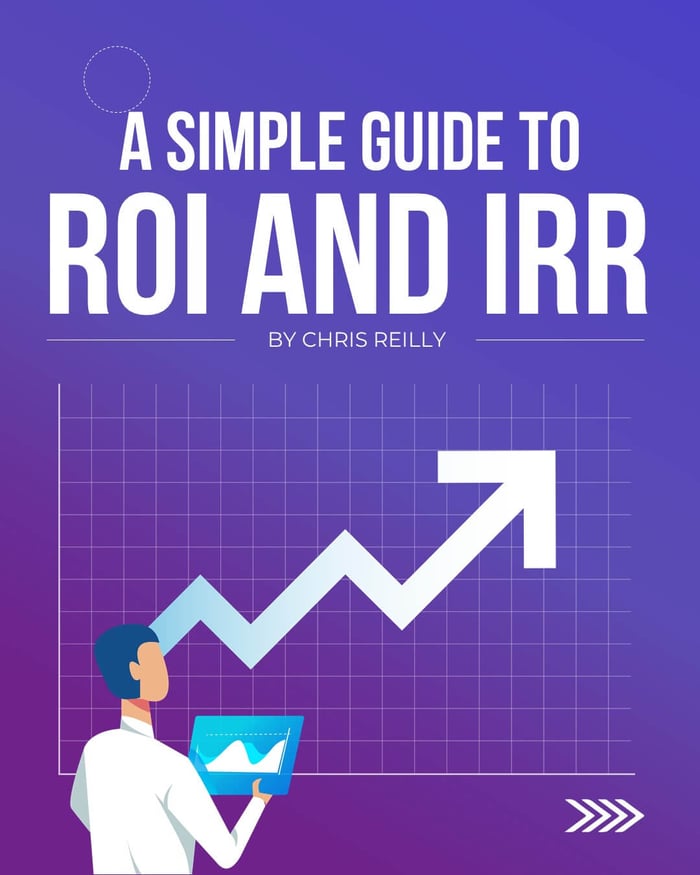Intro
When evaluating an investment, especially in the Private Equity setting, two terms are often thrown around:
- ROI
- IRR
What are they, and why do we need both?
Let’s discuss…
The Big Picture
ROI shows the return on my dollars.
IRR shows my ROI adjusted for time.
ROI (Easier One)
ROI is short for “Return on Investment,” and often goes by other names such as Multiple on Invested Capital (“MOIC”) or “Cash on Cash.”
(they all basically mean the same thing)
A Simple Example
Let’s say I invest $100 and get back $200…
My ROI is 2.0x ($200 / $100 = 2.0x).
If I invest $100 and get back $300, then my ROI is 3.0x.
($300 / $100 = 3.0x)
Easy enough.
IRR (The Tougher One)
Now, let’s introduce time.
Sticking with our example above: if I make 2.0x in one month, that’s great.
However, if I make 2.0x in 100 years… well… not so great.
So I need a way to measure my ROI over time as well.
IRR is short for “Internal Rate of Return,” and usually it is discussed alongside DCF and NPV analyses. However, for today’s post, I’d like to skip those topics and make it even simpler.
Let’s assume that IRR just means “annualized rate of return for an investment.”
In other words, “what percent did I make per year?” Maybe 10%, or 25%?
Revisiting Our Example
If I make 2.0x in just one month, that’s an IRR of 409,500% (and that’s really confusing).
If I make 2.0x in 100 years, that’s an IRR of 0.7% (which “visually” makes a little more sense).
This is why IRR can be misleading, and a common refrain I heard in my Private Equity days was, “you can’t spend IRR.”
The reason the numbers can look a little whacky is because IRR calculates an annualized percent return, so big returns in the early days can skew the numbers.
If I absolutely crush it in the first month (i.e., 2.0x in 30 days), my IRR formula is basically saying, “Whoa! You’re going to keep this up all year?! Nice!”
But in reality, it won’t play out that way.
Smooth it Out
The IRR starts to feel more “palatable” as time goes by. Take these examples:
- 2.0x after six months = 300% IRR
- 2.0x after one year = 100% IRR (I doubled-up in one year, and IRR is an annualized number, so it’s 100%)
- 2.0x after two years = 41% IRR
- 2.0x after three years = 26%
- 2.0x after four years = 19%
See how the IRR drops off steeply to begin with, and then smooths out? That’s why it can be misleading initially, but makes more sense as time goes by.
You Need Both
And this is why you need both ROI and IRR.
Without the other, they can both be misleading.
So you compare them side-by-side. Here’s your template:
As of [date], the ROI is [X] and the IRR is [Y].
Sticking with our example above: “If we invest $100 today and make $200 after two years, the ROI will be 2.0x and the IRR will be 73%”
Adding Some Complication
To be clear, the examples I’m using above exclude any dividends or return of cash along the way. Things get much more complicated when you factor in timing of cash flows.
For example, if I invest $100, get back $120 in month two and $80 back in month six, I’ve still generated an ROI of 2.0x, but my IRR will be higher than 300%.
(This is a conversation for another time, but in Excel, you can use the XIRR function to navigate this.)
Modeled Out
Here’s an example of how I show ROI and IRR in a classic M&A / Private Equity model.

ROI and IRR are shown together because I need to explain my return in both dollars and time.
Keeping It Straight in my Head
To keep it simple in my head, I just compare the IRR of any private investment to expected returns in the stock market.
For example, if I can open up a brokerage account for free, pay basically no fees, take my money out any time, and expect to make 7–10% on average each year (not financial advice)…
Then locking up my capital in an illiquid private investment (that has fees), must have a much higher IRR than 7–10%. The “IRR Premium” needs to compensate me for the additional risk I’m taking.
Gut check: This leads me to a common metric in the Private Equity world. Most deals target a 3.0x over five years as a “standard return.” This results in a 25% IRR: an initial goal post in a lot of financial models.
This 25% is much higher than what I can expect in the market (7–10%) and compensates me for the additional risk.
Conclusion
Is this an exhaustive dissertation on ROI and IRR? No. But it’s enough to keep things straight in my head.
I need to communicate my return in both dollars (ROI) and time (IRR) in order to understand the full picture.
That’s it for today. See you next time.
— Chris
p.s., if you enjoyed this post, then please consider checking out my Financial Modeling Courses.
As featured by the Wharton Online Private Equity Certificate Program, Wall Street Prep, LinkedIn Learning (and more), you'll learn to build the exact models I use with Private Equity and FP&A teams around the world.
Thanks for reading.

